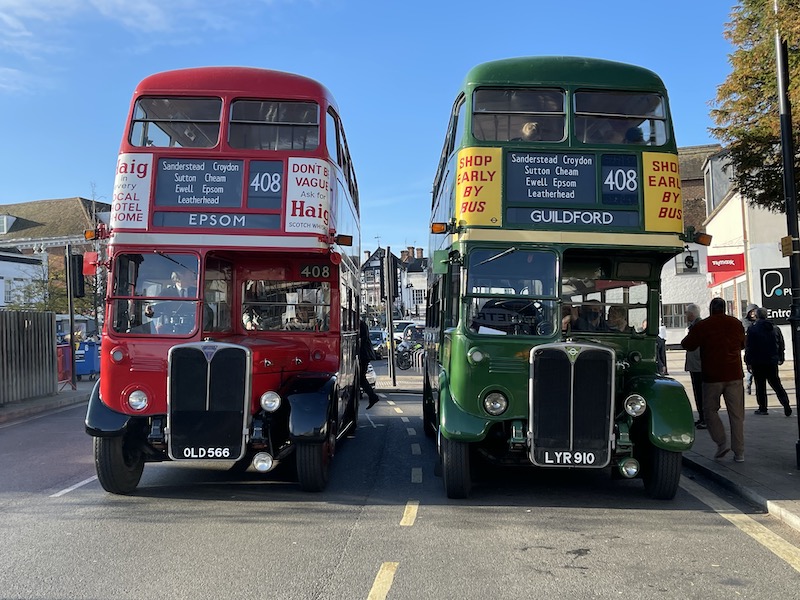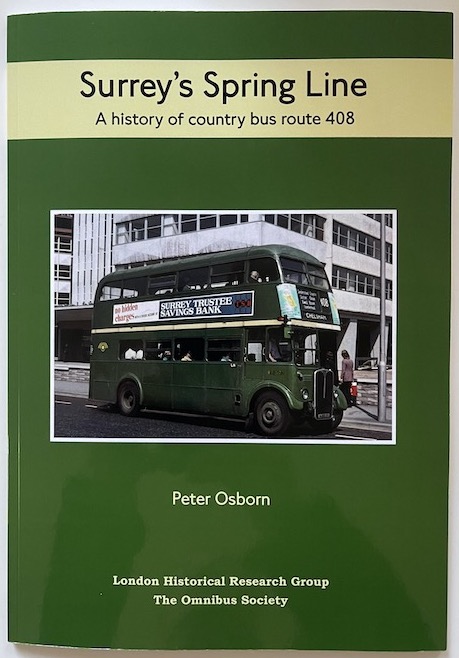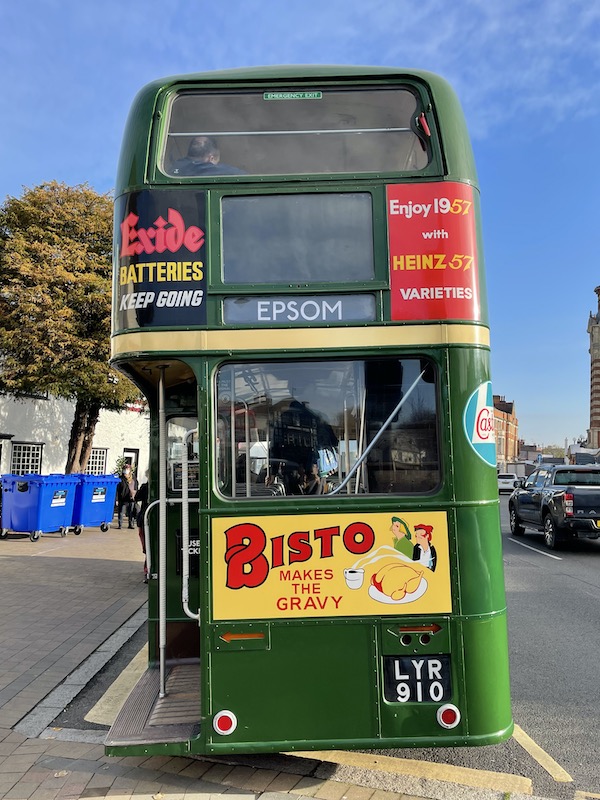Thursday 18th November 2021

We all have a favourite bus route – usually one associated with childhood memories often from the days of taking us to and from school.
Peter Osborn’s favourite must be the former London Country route 408 which at one time ran from Guildford via Leatherhead and Epsom to West Croydon before continuing south eastwards to Warlingham and Chelsham.

Not only has Peter recently published a book about the history of the route entitled ‘Surrey’s Spring Line’, but on Tuesday he organised a special running day using his own preserved RT 4779 offering free rides to all comers to mark the exact centenary date of the route’s introduction on 16th November 1921.

It wasn’t numbered 408 at that time, the ‘Bassom’ system of numbering bus routes in the Metropolitan Police area was introduced three years later in 1924, so East Surrey Traction Co Ltd (the forerunner in the south west to London Transport’s country area operations formed in 1933) christened its fledgling Guildford to Epsom bus service as route S6B – an associate of route S6 which ran from Epsom to Redhill.
Frequency was initially two hourly and it took 100 minutes end to end but in the following April the route was extended north east via Ewell and Cheam to Sutton and increased to hourly while in June was renumbered S8 (hence ultimately becoming 408) and in March 1923 was further extended north eastwards to West Croydon.

There’s a fascinating story about how buses on the 408 inter-worked with the 403 and 415 in the mid 1930s to provide a cross-Croydon service and I recommend buying Peter’s book for an easy to understand explanation of what was a very complicated arrangement. The upshot was route 408 got extended again beyond West Croydon via Warlingham and Chelsham to Farleigh as well as some journeys to Warlingham Park Hospital in 1937.

By the early 1960s the eastern terminus had become Chelsham with a lengthy 2 hours 16 minutes journey time from Guildford but in June 1972 the route was cut back to West Croydon when converted to driver only operation.
The route became a limited stop ‘408 Express’ in 1980 with 20 minutes lobbed off the running time bringing it down to 1 hour 36 minutes although in his book Peter wryly observed this saving was “probably reflecting the decline in patronage more than time gained by missing stops”. It didn’t prove a success possibly not helped by replacing the Atlanteans with Leyland Nationals.
All this came to an end in June 1999 when the route south of Leatherhead (to Guildford) was withdrawn and in January 2000 was cut east of Sutton (to Croydon), both being replaced by other routes, while the western end of the route saw a handful of journeys extended to Cobham via Oxshott.

In July 2003 the northern terminus was cut back from Sutton to Epsom and by now the 408 had sadly become a minnow compared to its trunk route heritage. Some journeys from Epsom were diverted to run to Effingham rather than Cobham in 2012 and that continues to be the case today with the route operated by Falcon Coaches.

Meanwhile Peter explains in his book the current services which you can catch to make the same Guildford to West Croydon journey which for so many years was possible simply by catching the 408. They include the 478/479, the current shortened 408, Metrobus 21, TfL routes 470, X26, 407 and 410.
But on Tuesday the 408 was back again to its original route for one day only thanks to Peter and his RT together with Simon and his resplendent green liveried RT 3491 which once again recreated the route in its entirety between Guildford and West Croydon. Many route 408 fans took the opportunity to accept the generous offer of a free ride for a rounder from Epsom down to Guildford then right through to West Croydon and back to Epsom.

This RT duo were also joined by preserved green liveried RT 3148 making for a convoy of three RTs for the journey from Epsom to Guildford.

The team arranged for some photo stops along the route which were enthusiastically taken up by everyone on board, needing to show some patience to get that perfect shot too on the busy roads the 408 used to ply.


At Guildford a quick trip to Arriva’s soon to close bus garage in Leas Road, formerly home to London Transport Country Buses (as well as London Country) provided a fitting tribute to this long standing garage which dates back to 1932.



The run from Guildford to West Croydon was achieved in about 85 minutes which was good going, comparing well with the 96 minutes taken by 408 Express journeys, and made for a very enjoyable nostalgic morning.

On arrival in West Croydon bus station it was good to see both RTs attracting attention from both staff and passengers using TfL’s extensive network of bus routes at this busy location.

Many thanks to Peter for organising such a splendid tribute marking one hundred years since route 408 first began as the S6B.

Copies of Peter’s splendid book were on sale on the buses and is recommended reading for anyone interested in bus routes in this part of Surrey and south west London.
The book is also selling fast from other outlets but it is still available online through this link. Buy a copy before you miss out. It’s a bargain at £10.

Roger French



It is very difficult to re-create such nostalgia with current traffic levels and changing road systems these days, not to mention gawping onlookers who haven’t a clue what it is all about, but this looks to have gone well. Coming south from Staffordshire as a child, found us living close to Chelsham garage, so the 408 was an early introduction to London Transport and although moving away later, thanks to my Parents habit of changing houses every two years, a later two moves and one during, re-introduced me to the 408 as a passenger during my entire senior school years. Slow, but always busy along all sections, and you froze to death during the Winter months are my abiding memories. What a chance to be able to photograph the vehicles at Leas Road just prior to closure, although the buildings are far from the original, and what a pity the Warlingham end was not covered as that of course represented the RT era. But really good to see.
LikeLike
I didn’t realize that TFL had some X bus routes.It is an interesting protocol with putting the X most put it in front of the number for example X5 but some put it behind say 43X.Years ago I noticed that the joint United/West Yorkshire service 36, and variants, between Ripon and Leeds had both a X36 and a 36X.The X36 was a main service ,a fast 36 basically,but the 36X seemed to be a variation of route 36 and semi fast over a certain section plus very infrequent.The London Transport Red Arrows buses where internal short distance express services within central London but didn’t carry an X being,if I recall,400’s?
LikeLike
Pity I missed this, I’d have loved a jaunt on the 408… I must be a member of the wrong clubs, I never saw any details on the lots I look at! 😢
LikeLike
Re X-numbered services. Here in Cardiff one of local (services, run by Adventure Travel, has always been the X1 – the X standing for “cross-city”. It has just been renumbered C1 which brings it in line with their other Cardiff routes, which seems to make sense, especially as Newport Bus run an hourly X30 express service into Cardiff (this doesn’t seem to be a joint route, unlike the “regular” 30).
LikeLike
HERT – Herts and Essex Rapid Transport
Proposed raoid transport system between Harlow Gilston St Albans Watford
Seems to be very speculative at present with no real detail and no funding It could possibly incorporate the St Albans Abbey line. If it happns it would probably finih off the 724 Greenline
LikeLike
Hmm, Bob. The Abbey Line +the Nickey Line +the Bunt+. It’s been around for 100 years +. Might upset a few people, though. Who’d use it? The 724 problem.
Or a cut price version of CrossRail 2?
LikeLike
I am just speculating it might inconporate theAbbly line. The info on the HCC site is very vague, Greenline 724 does not generate very much traffic between these places. There is also an old railway line between Hatfield and St Albans at least some of the track bed is intact
Would such a route generate much traffic ?
https://www.hertfordshire.gov.uk/services/highways-roads-and-pavements/roadworks-and-road-closures/major-roadwork-projects/hert.aspx#DynamicJumpMenuManager_1_Anchor_1
LikeLike
There is an inherent problem with HERT . . . in order to attract sufficient passengers to succeed, it must serve population centres. Running fast via bypasses won’t work. You MUST get close to homes . . . asking a passenger to get into a car to reach a bus hub and then leave the car behind . . . nah!!
However, in Hertfordshire it’s the population centres that have the worst traffic . . . so any fast bus route will take too long.
From Watford to Stansted Airport will take me around 1 hour or so. I have a flight at 0900, so must check in at 0700 . . . I’ll leave home at around 0530 and park at the Airport . . . will there be a bus at around 0430? No.
Almost any journey across Hertfordshire will be quicker by car . . . so why compete??
Double the service levels in towns . . . improve bus priorities . . . increase car park prices . . . THAT is how to reduce traffic levels and emissions. Do that first . . . any fancy ideas can come later.
LikeLike
Do we ever look beyond our own backyard? That’s exactly what FEx have done. 2, 3 or 4 bph timetabled, it makes no difference, we still wait an hour for a bus. The latest wheeze is to cut a third of the timetable, randomly in Essex, or just take every third bus out of the timetable by Arriva in Stevenage. Unfortunately , we just don’t have the time to spend standing around!
Herts though has one big advantage. The buses do run, more or less to time (as true for Stephensons, Ensign, even Stagecoach) . That’s the first point, though apparently not for First in Essex!
LikeLike
There are a number of old railway lines such ass the Hertford to WGC line. How much of the track bed is left I dont know
Councils love to go for very expensive and very inflexable tram systems. A better approach would be a hybrid trolley bus. Where old railway way lines aravavilable they couild run on an overhead line with a return path though the track bed as that simplifies engaging and disengaging with the overhead line. When off the track bed it could run om batteries this enables them to run it to the town centres most of the old lines had stations away from the town they served
LikeLike
Bob . . . it’s an idea . . . in practice the Luton-Welwyn Gdn City-Hertford; Hemel Hempstead-Harpenden; St Margarets-Buntingford and St Albans-Hatfield lines have only isolated stretches left; normally in open country.
A fair amount of “infilling building” or conversion to road bypasses has taken place . . . in any case, a single-track branch line isn’t big enough for a 20ft road, so some more land-grab would be necessary. Most of those lines have been closed for over 50 years now . . .
LikeLike
Unfortunatly when they closed the lines they did not prorect the track beds
Building any new tranport systm in the UK is always problomatic as the UK is so overcrowded
The HCC document has little detail other then the proposed scheme would broadly follow the A414
If you use hybrid trolley buses you get a lot off flexibility. True old track beds are narrow. A low cost solution is to have passing loops
Who know even if the HCC scheme will even see the light of day or even what type of vehiclles it would use. . I cannot see a bus labe on the A414 being pracricable
LikeLike
Or something really radical close the A road and build a railway on it…. without parkways!
LikeLike
A magic solution . Replace a road network which can’t cope, with a rail network which can’t cope either.
What it surely needs is a snappy nickname to capture the public imagination. How about the Ninky Nonk! That should do it, and attract the Government funding.
LikeLike
… the possibilities are endless. The teddy bears’ picnic.
LikeLike
What a great event. And a timely reminder of the proud history of bus travel.
LikeLike